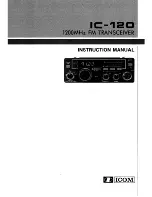
9
Frequency Agile UHF Belt-Pack Transmitter
Rio Rancho, NM – USA
7)
While speaking or singing at the same voice level that will actually be used, observe the MODULATION LEDs.
Adjust the AUDIO LEVEL control knob until the LEDs begin to light. Start at a low setting where neither LED lights
as you speak. Gradually, turn the gain up until one LED lights, then the other.
The -20 LED lights when the audio level is about 12dB below full modulation. The “0” LED lights when the limiter
begins to operate. There is over 30dB of limiting range without overload above the “0” LED, so it is desirable that
the it lights up 5% to 10% of the time during use.
8)
Once the gain has been adjusted, the audio system audio can be turned on to make level adjustments. Set the
power switch to the ON position and adjust the receiver and/or sound system level as required.
Please note,
there will be a delay between the moment the switch is thrown and the time when audio will actually
appear at the receiver output.
This intentional delay eliminates turn on thumps, and is controlled by the pilot tone
squelch control.
OPERATING NOTES
The AUDIO LEVEL control knob should not be used to control the volume of your sound system or recorder levels.
This gain adjustment matches the transmitter gain with the user’s voice level and microphone positioning.
If the audio level is too high — both LEDs will light frequently or stay lit. This condition may reduce the dynamic range
of the audio signal.
If the audio level is too low — neither LED will light, or the -20 LED will light dimly. This condition may cause hiss and
noise in the audio, or pumping and breating in the background noise.
The first LED turns on 12dB below full deviation. The “0” LED turns on at full deviation and indicates that the input
shunt compressor is operating. The input limiter will handle peaks over 30dB above full modulation, regardless of the
gain control setting. The limiter uses a true absolute value circuit to detect both positive and negative peaks. The
attack time is 5 milliseconds and the release time is 200 milliseconds. Occasional limiting is desirable, indicating that
the gain is correctly set and the transmitter is fully modulated for optimum signal to noise ratio.
Different voices will usually require different settings of the AUDIO LEVEL control, so check this adjustment as each
new person uses the system. If several different people will be using the transmitter and there is not time to make the
adjustment for each individual, adjust it for the loudest voice.
ADJUSTING THE TRANSMITTER FREQUENCY
If you are experiencing interference from another signal on your frequency, you may want to change the operating
frequency of your system. The left switch changes the operating frequency by 1.6 MHz per step and the right switch
changes it 100 kHz per step. If you are experiencing interference, change the operating frequency in 100 kHz steps to
find a clear channel. If it is not possible to find a clear channel using the 100 kHz switch, return it to its original
position and change the 1.6 MHz switch by one click then try the 100 kHz switch again.
To gain access to these switches, slide the access door sideways with a
fingernail.
Note:
With the UDR200A receiver, these switches also appear on the front
panel of the receiver. Normally, you should set the transmitter switches to
match the receiver switch settings.
With the UDR200B receiver, the front panel LED character display will indicate
the correct transmitter switch settings.
0 1
2
3
4
5
6
7
8
9
A
B
C
D
E
F
0 1
2
3
4
5
6
7
8
9
A
B
C
D
E
F



































